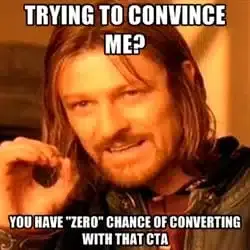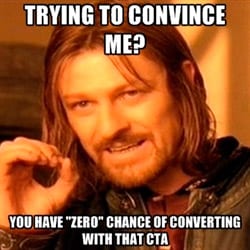
A call to action is exactly what it sounds like. It’s the message that gets people moving, that motivates them to take the next step in the buying process. A good call to action means you’ll achieve your goals, whether it be to build your email list or to sell people on why they need a particular item.
If that call to action isn’t present, you’re basically telling people that they don’t need to take action. That, of course, guarantees that people won’t take that next step.
So, then, how can you optimize your calls to action?
Provide Value to the Customer
Even the best call to action will fall on deaf ears if the customer doesn’t understand what’s in it for them. A winning call to action demonstrates, in very clear language, how the customer will benefit from heeding the message they’ve received.
For example, imagine you want to build up a customer database that you can contact with promotional information. Simply putting up a form on your website isn’t going to get the job done. Similarly, nobody wants to give out their email address just so they can get spammed with content they don’t want.
What can you do? It’s easy. Give them something they do want. This is not only a sign of good faith to the customer, but it makes a bold statement of what you’re all about. A good item to exchange in this situation would be a white paper or exclusive industry content, something the customer can’t get anywhere else.
Every situation is different, and it’s not always so easy to get responses. As long as you remember to view your calls to action from the customer’s perspective, you can’t go wrong.
Speak the Language of Action
By definition, a call to action isn’t a passive thing. It’s something to be taken seriously, to encourage the reader to immediately respond. You don’t get that sort of response by pussyfooting around the issue.
Actionable language is essential for crafting the perfect call to action. At its essence, actionable language is a way to tell people what to do without sounding too pushy. All you have to do is move the verb to the beginning of the sentence, and you’ve got copy that’s far more likely to convince the reader to take action. For instance, you could spend three sentences rambling about why customers should download your white paper. Or, you could simply say “Download our FREE white paper!” and let the reader find the benefits for themselves.
Always speak directly to the reader as you use your actionable words. This eliminates the barriers between you and the recipient. It also helps them understand that they’re the ones who should take action now.
Customize Your Calls
All people are different, and what works for one customer might not work for another. That’s why it’s so important to segment your customer base and send out unique calls of action to each of your customer groups.
There are many different ways to divide customers and prospects. Gender, location and age are common demographics that can be used, but you can also look inside at your own data. You probably view repeat customers differently than you look at people who have registered for your site, but have never bought anything.
Use that to your advantage! Craft one call of action for your loyal customers, then create a stronger one for those that you really want to take the next step in the buying process.
Segmenting is almost always a good idea, but be sure to double-check your copy before distributing marketing materials to your customers. The absolute worst thing you could do is send the wrong email to the wrong group. Such a blunder would eliminate the personal touch that goes so far in convincing people to take action.
Source: http://blog.hubspot.com/marketing/call-to-action-optimization-ht
